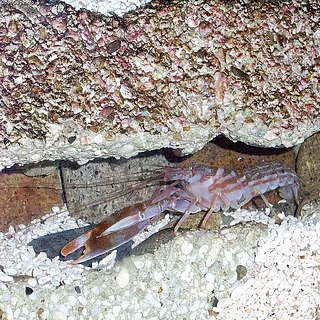
Alpheus is a genus of snapping shrimp of the family Alpheidae. This genus contains in excess of 291 species, making this the most species-rich genus of shrimp. Like other snapping shrimp, the claws of Alpheus are asymmetrical, with one of the claws enlarged for making a popping noise. Some species in the genus enter into symbiotic relationships with gobiid fishes, and others associate with sea anemones. It's also the noisiest of all sea creatures and can immobilize small fish with its high pitched frequency.
Alpheopsis is a genus of shrimp of the family Alpheidae. Several species of the genus have been known to share the same burrows with members of different species. They are inhabitants of the Eastern Pacific Ocean.

Athanas is a genus of shrimp of the family Alpheidae. These are small shrimp measuring 2 cm in length. Females have smaller chelae than males.

Automate is a genus of pistol shrimp of the family Alpheidae, containing the following species:
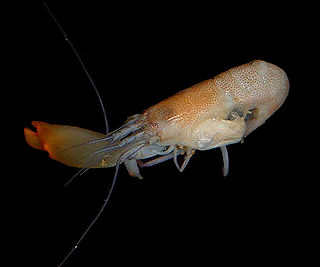
Synalpheus is a genus of snapping shrimp of the family Alpheidae, presently containing more than 100 species; new ones are described on a regular basis, and the exact number even of described species is disputed.

Diadema setosum is a species of long-spined sea urchin belonging to the family Diadematidae. It is a typical sea urchin, with extremely long, hollow spines that are mildly venomous. D. setosum differs from other Diadema with five, characteristic white dots that can be found on its body. The species can be found throughout the Indo-Pacific region, from Australia and Africa to Japan and the Red Sea. Despite being capable of causing painful stings when stepped upon, the urchin is only slightly venomous and does not pose a serious threat to humans.
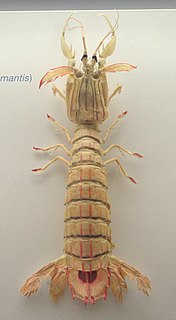
Squilla mantis is a species of mantis shrimp found in shallow coastal areas of the Mediterranean Sea and the Eastern Atlantic Ocean: it is also known as "pacchero" or "canocchia". Its abundance has led to it being the only commercially fished mantis shrimp in the Mediterranean.

Astropyga radiata, the red urchin, fire urchin, false fire urchin or blue-spotted urchin, is a species of sea urchin in the family Diadematidae. It is a large species with long spines and is found in the tropical Indo-Pacific region. It was first described in 1778 by the German naturalist Nathaniel Gottfried Leske.

Heterocentrotus mamillatus, commonly known as the slate pencil urchin, red slate pencil urchin, or red pencil urchin, is a species of tropical sea urchin from the Indo-Pacific region.

Toxopneustes pileolus, commonly known as the flower urchin, is a widespread and commonly encountered species of sea urchin from the Indo-West Pacific. It is considered highly dangerous, as it is capable of delivering extremely painful and medically significant stings when touched. It inhabits coral reefs, seagrass beds, and rocky or sandy environments at depths of up to 90 m (295 ft). It feeds on algae, bryozoans, and organic detritus.

Echinometra mathaei, the burrowing urchin, is a species of sea urchin in the family Echinometridae. It occurs in shallow waters in the Indo-Pacific region. The type locality is Mauritius.

The Camarodonta are an order of globular sea urchins in the class Echinoidea. The fossil record shows that camarodonts have been in existence since the Lower Cretaceous.
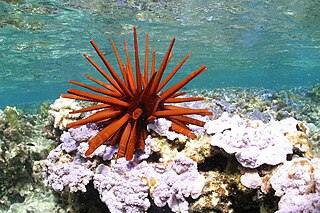
The Echinometridae are a family of sea urchins in the class Echinoidea.
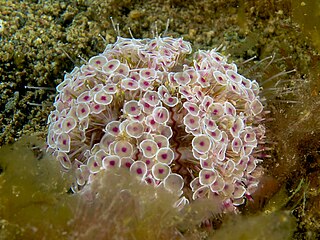
Toxopneustes is a genus of sea urchins from the tropical Indo-Pacific. It contains four species. They are known to possess medically significant venom to humans on their pedicellariae. They are sometimes collectively known as flower urchins, after the most widespread and most commonly encountered species in the genus, the flower urchin. Species included in the genus are the following:

Echinometra viridis, the reef urchin, is a species of sea urchin in the family Echinometridae. It is found on reefs in very shallow parts of the western Atlantic Ocean and the Caribbean Sea.

Chaetodiadema is a genus of sea urchins of the Family Diadematidae. Their armour is covered with spines.

Toxopneustes roseus is a species of sea urchin from the East Pacific. It is sometimes known as the rose flower urchin or the pink flower urchin. Like the related flower urchin, they are venomous.

Toxopneustes maculatus is a rare species of sea urchin found in the Indo-West Pacific.
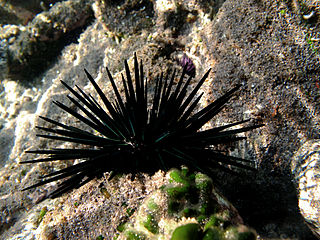
Stomopneustes variolaris, the black sea urchin or long-spined sea urchin, is a species of sea urchin, the only one in its genus Stomopneustes and only species still alive in its family Stomopneustidae. It is found throughout the tropical Indo-Pacific, with a patchy distribution.
Automate branchialis is a species of pistol shrimp from the family Alpheidae which was thought to be a Lessepsian migrant, i.e. a species which had colonised the Mediterranean from the Red Sea via the Suez Canal. This was because before its description in 1958 all the species of the genus Automate were found in the Indo-Pacific region. A. branchialis has not been recorded in the Indo-Pacific region and has been found to be widespread in the Mediterranean so it is now considered to be a Mediterranean endemic.


















